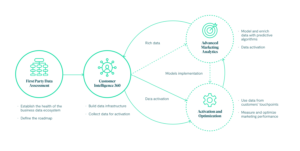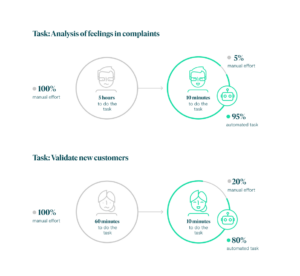The 2021 Black Friday edition reported USD 8.9 billion sales globally, according to Adobe. On this date, according to Salecycle, the shopping cart abandonment rate dropped to 76%, less than the annual average, which stands at 81%. In addition, according to Publicis Sapient, 74% of consumers prefer to shop online during these periods. Devices will also play an increasingly important role: according to a Zebra study, 92% of shoppers are ordering via mobile devices.
How optimize your eCommerce performance this Black Friday? Following, we offer you 10 tactics in two topics: Digital Analytics and Automation.
This article is divided into two parts. In the second part, we offer you 5 tactics in Marketing.
5 Digital Analytics tactics for this Black Friday
1. Ensure your campaigns’ measurement
When launching seasonal campaigns, an essential point that we usually come across is a disconnection between the Marketing and Analytics teams.
We recommend starting by verifying that the measurement of your campaigns and media complies with the necessary configurations to correctly track the user. For example, make sure that the conversion pixels of the different channels such as Facebook, Instagram, Youtube, are properly installed on the site. Also, that the UMTs parameters to be used during the seasonality, and that the configurations within your Tagging and Analytics tools are updated for the correct tracking. This will allow not only to record the performance from the reports of the Paid Media (Ads) platforms, but also to have a connection with the user experience in your digital asset.
Building a verification matrix together with your team so that everything is ready before campaigns are launched is advised.
2. Create a dashboard to analyze conversions rate
When launching campaigns, we recommend you to have a specific control panel or dashboard for them. This way, you will be able to monitor in real time everything that is happening during the campaigns.
Based on monitoring, it will be important to take action. The benefits of agility to actively correct errors or introduce changes will be evident.
Ideally, if the dashboards, in addition to tracking conversion KPIs (e.g. conversion rate, acquisition cost), also consider indicators related to user experience (e.g. loading times per device, on-site error tracking).
3. Monitor campaigns before, during and after Black Friday.
When it comes to analysis and monitoring, we advise that you make the most of your data and use segmentation of buyers and prospects.
Analyze why your visitors had purchase intent but left the site and seek to answer questions such as “What products were they looking for?”, “Did they compare prices?” or “What was the most frequent abandonment point?”. We recommend making use of active feedback tools such as surveys with prospects who have taken certain actions (e.g. triggering the survey when you detect that they will be leaving the site).
Propose actions with your Experience, Marketing and Digital Strategy teams. Analyze what happened once the campaign was over, analyze as a team points of improvement to optimize your processes and get the most out of future seasonal sales. It is enriching to learn by analyzing the information from different perspectives and implementing new actions in future campaigns.
4. First Party Data based actions in your campaigns
First party data will provide reliable and quality data of your users. Thanks to the analysis of this data, you will be able to detect in an agile and simple way the tastes, preferences and changes in habits of customers. Thus, the profitability of your marketing actions will be improved, since these will be more precise.
In addition, it will be the basis to go further in audience segmentation and campaign personalization. For example, at Multiplica we were able to increase the effectiveness of shopping cart recovery campaigns by 54% for an important eCommerce in Colombia, through the application of a cluster segmentation model.
Through A/B tests, during a period of one month, we carried out, together with the Marketing team, SMS recovery strategies to 50% of the users who abandoned some of the steps and the remaining 50% were not sent any SMS. Generating an impact of 36% in order recovery, in the users impacted by SMS.
Moreover, by generating valuable audiences and recognizing customer preferences, we developed a recommendation engine created with Machine Learning algorithms that allows personalizing the user experience with product recommendations on the checkout page.

Multiplica’s methodology takes a first party data strategy as a starting point to built advanced analytics projects.
5. Integrate your systems for better decision making
We all shape the shopping experience, and what could be better than having an integration of our systems to obtain more accurate data that leads us to make decisions from different angles.
Although marketing analytics tools help us make more effective decisions about our campaigns, it is a reality that product availability and customer service issues play a fundamental role.
Paying attention to our CDPs and integrating them with our marketing helps us have a more strategic vision on issues such as real product availability versus demand, anticipate stock-outs, better organize logistics, deliveries as well as distribution, and work on after-sales service.
The integration of systems also allows working on the prediction of our customers’ behavior in order to make increasingly informed decisions and move towards the personalization of experiences and the efficiency of marketing investments.
5 Automation tactics for this Black Friday
1. Consider Automation for more effective campaigns
RPA (Robot Process Automation) will help you make better use of your time so you can focus on creative tasks.
These techniques help automate internal processes – logistics, accounting, supplier payment, purchase orders and even user feedback, among many others – and thus save manual and low value-added work.
However, reducing the burden of repetitive tasks is not the only thing that RPA is good for. By making smarter use of the data collected from different sources you will be able to think and plan more effective and accurate strategies to increase your sales this Black Friday.
2. Diagnose to detect improvement points in processes
Analyzing what happened in previous years and determining which were the processes –or parts of them– in which mistakes were made or which caused bottlenecks allows increasing the quality of logistics, administrative and customer services, among others.
To this end, it is essential to review and optimize processes before starting automation, because if automation is carried out on an efficient process, efficiency will be maximized.
In this situation, we recommend starting by optimizing simple processes and then increasing the complexity, so that control over what is happening can be maintained.
3. Detect Quick Wins to optimize time of tasks
Prior to embarking on a complex automation project, we recommend detecting the Quick Wins that can help you in these particular campaigns, as you will be able to evaluate the times, budgets and even the ROTI (Return of Time Invested) of all your automation actions. Following this, continue with the automation of more complex or less digitized processes within the company.

The automation of processes allows significant savings in the execution time of manual tasks.
4. Automate conversations with clients
Periods such as Black Friday, bring with them a greater need for customer service, both during the purchase process and post-sale. Chats that automate basic conversations are the best ally to meet this demand. When applied to chats, automation makes it easier to answer basic questions, while learning and developing new answers, depending on each interaction with users. In this way, you will be able to provide your customers with more fluid, natural and effective conversational experiences.
According to Gartner, by 2022, 70% of interactions between customers and businesses will be through machine learning applications, chatbots and mobile messaging.
This greatly helps reduce workloads and optimize the relationship with clients, in addition to freeing up the time of collaborators.
5. Imagine and plan for the long term
Defining automation strategies for the future is paramount to the success of your organization in this information age.
Whether from specific projects that are born for this period or for any other time of the year, analyzing the results, extracting lessons learned and defining strategies that last throughout the year is key to gain competitiveness in an increasingly technological world.
Gartner also anticipates that thanks to automation, retail companies – along with the healthcare and banking sectors – will save around USD 11 billion by 2023, so implementing such solutions is becoming increasingly important.
Is your eCommerce ready to take the next step? If you want to learn more about how we can strengthen and improve your processes for seasonal sales, do not hesitate to contact me.